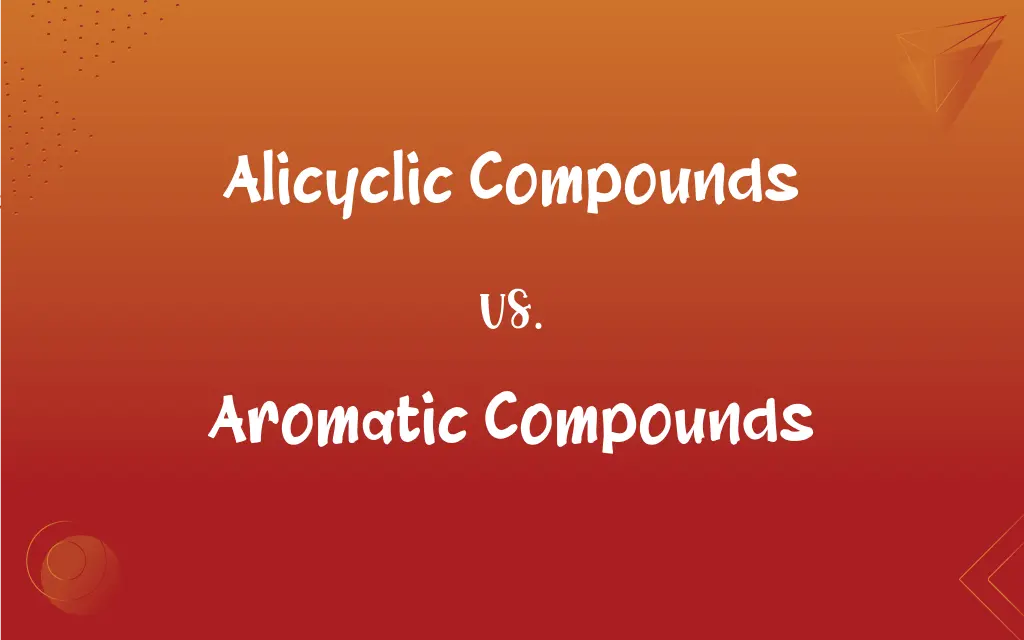Alicyclic Compounds vs. Aromatic Compounds: What's the Difference?
Edited by Aimie Carlson || By Harlon Moss || Published on January 21, 2024
Alicyclic compounds are organic molecules with cyclic structures and no aromatic character, while aromatic compounds contain a planar ring system with delocalized electrons.

Key Differences
Alicyclic compounds are characterized by their non-aromatic, ring-shaped structures, similar to alkanes, alkenes, or alkynes. Aromatic compounds have a unique planar ring structure with delocalized pi electrons.
Alicyclic compounds generally exhibit chemical properties similar to their acyclic counterparts. Aromatic compounds, on the other hand, are known for their high stability and distinctive reactions due to their electron-rich rings.
Alicyclic compounds typically undergo reactions similar to open-chain compounds, like addition reactions. Aromatic compounds often participate in substitution reactions, retaining their aromatic ring.
Alicyclic compounds include cyclohexane and cyclopentane, found in various organic substances. Aromatic compounds, like benzene and naphthalene, are common in chemicals and pharmaceuticals.
Alicyclic compounds lack the aromatic stability seen in aromatic compounds. Aromatic compounds are more stable due to resonance, a key feature of aromaticity.
ADVERTISEMENT
Comparison Chart
Structure
Non-aromatic rings
Planar rings with delocalized electrons
Chemical Properties
Similar to acyclic compounds
High stability, unique reactions
Typical Reactions
Addition reactions
Substitution reactions
Common Examples
Cyclohexane, cyclopentane
Benzene, naphthalene
Aromatic Stability
Lacks aromatic stability
High stability due to resonance
ADVERTISEMENT
Alicyclic Compounds and Aromatic Compounds Definitions
Alicyclic Compounds
Cyclic molecules lacking the stability of aromatic rings.
Despite not being aromatic, alicyclic compounds play a crucial role in synthesis.
Aromatic Compounds
Organic chemicals characterized by stable ring structures and delocalized electrons.
Benzene, a common aromatic compound, is fundamental in organic chemistry.
Alicyclic Compounds
Organic compounds with cyclic structures but no aromatic character.
Cyclohexane is an alicyclic compound used in various chemical syntheses.
Aromatic Compounds
Ring-containing compounds with high chemical stability due to electron delocalization.
The stability of aromatic compounds like toluene makes them valuable in industry.
Alicyclic Compounds
Non-aromatic, ring-containing molecules in organic chemistry.
Alicyclic compounds are often used as intermediates in industrial processes.
Aromatic Compounds
Substances with a unique ring structure, often used in pharmaceuticals.
Many drugs are based on aromatic compounds due to their reactive nature.
Alicyclic Compounds
Ring-shaped organic molecules, not classified as aromatic.
Alicyclic compounds like cyclopentane are key in organic chemistry.
Aromatic Compounds
Electron-rich organic molecules, essential in various chemical reactions.
Aromatic compounds are key players in the synthesis of complex organic products.
Alicyclic Compounds
Cyclic organic substances resembling aliphatic compounds.
The study of alicyclic compounds reveals important aspects of molecular structure.
Aromatic Compounds
Molecules with a planar ring system exhibiting resonance.
Naphthalene, an aromatic compound, is known for its distinctive scent in mothballs.
FAQs
What makes aromatic compounds unique?
Aromatic compounds have a planar ring system with delocalized electrons, providing high stability.
What defines an alicyclic compound?
Alicyclic compounds are cyclic organic molecules without aromatic character.
What are common uses of aromatic compounds?
Aromatic compounds are widely used in chemicals, pharmaceuticals, and dyes.
Are alicyclic compounds reactive?
Alicyclic compounds can be reactive, but their reactions differ from those of aromatic compounds.
What is the role of delocalized electrons in aromatic compounds?
Delocalized electrons contribute to the stability and unique reactivity of aromatic compounds.
What is a common example of an alicyclic compound?
Cyclohexane is a well-known example of an alicyclic compound.
Are alicyclic compounds found in nature?
Yes, many alicyclic compounds occur naturally in various organic substances.
What is an aromatic compound?
Aromatic compounds are organic chemicals with a stable ring structure and delocalized electrons.
Can alicyclic compounds be synthesized?
Yes, alicyclic compounds can be synthesized for various industrial and research purposes.
How do alicyclic compounds differ from aliphatic compounds?
Alicyclic compounds have a cyclic structure, unlike linear or branched aliphatic compounds.
What is an example of a polyaromatic compound?
Naphthalene, consisting of two fused aromatic rings, is a polyaromatic compound.
Can aromatic compounds be harmful?
Some aromatic compounds, like benzene, can be toxic and are handled with care.
Are alicyclic and aromatic compounds soluble in water?
Generally, both types of compounds have low solubility in water.
What types of reactions do aromatic compounds undergo?
Aromatic compounds typically undergo substitution reactions.
What is the Hückel rule for aromatic compounds?
The Hückel rule states that aromatic compounds have 4n+2 pi electrons.
How are aromatic compounds identified?
Aromatic compounds are identified by their distinctive ring structure and electron delocalization.
How are alicyclic compounds used in industry?
Alicyclic compounds are used as intermediates in the synthesis of various chemicals.
Do alicyclic compounds participate in resonance?
No, alicyclic compounds do not exhibit the resonance characteristic of aromatic compounds.
Can alicyclic compounds be aromatic?
Alicyclic compounds are non-aromatic by definition, though some can exhibit aromatic-like properties.
How do alicyclic and aromatic compounds impact the environment?
Their impact varies; some can be pollutants, while others are used in green chemistry.
About Author
Written by
Harlon MossHarlon is a seasoned quality moderator and accomplished content writer for Difference Wiki. An alumnus of the prestigious University of California, he earned his degree in Computer Science. Leveraging his academic background, Harlon brings a meticulous and informed perspective to his work, ensuring content accuracy and excellence.
Edited by
Aimie CarlsonAimie Carlson, holding a master's degree in English literature, is a fervent English language enthusiast. She lends her writing talents to Difference Wiki, a prominent website that specializes in comparisons, offering readers insightful analyses that both captivate and inform.






































































